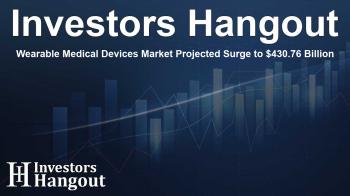Wearable Medical Devices Market Projected Surge to $430.76 Billion

Exploring the Wearable Medical Devices Market Growth
The global wearable medical devices market is on track for significant growth, expected to expand from USD 53.81 billion in 2025 to a staggering USD 430.76 billion by 2034. This growth trajectory represents a compound annual growth rate (CAGR) of 26%, signaling robust demand in the healthcare sector.
What Are Wearable Medical Devices?
Wearable medical devices are innovative tools that patients can easily attach to their bodies to capture essential health and fitness data. Examples include biosensors, fitness trackers, and blood pressure monitors. These devices play an integral role in modern healthcare by enabling earlier detection of health issues, promoting remote patient monitoring, and enhancing access to vital health information.
Benefits of Wearable Technology
By allowing continuous monitoring of vital signs, these wearable devices help in managing chronic diseases, detecting diseases early, and facilitating proactive health management. They empower users to take charge of their health by providing real-time feedback about their health status.
Driving Forces Behind Market Expansion
Several factors are contributing to the increase in demand for wearable medical devices:
- Rising Chronic Diseases: As chronic diseases become more prevalent, demand for devices that can offer continuous health monitoring increases significantly.
- Aging Population: The growing senior demographic necessitates advanced health management solutions, including medication reminders and fall detection technologies.
- Technology Integration: The convergence of artificial intelligence (AI) and the Internet of Things (IoT) is revolutionizing wearable devices. These technologies enable better tracking and analysis of user data, facilitating more personalized healthcare.
The Role of AI in Wearables
Artificial intelligence enhances wearable medical devices through applications such as mental health tracking, sleep monitoring, and fall detection. Deep learning and machine learning technologies are pivotal in improving the functionality and reliability of these devices.
Market Insights and Trends
In 2024, North America led the wearable medical devices market, capturing 39.1% of the total share. Other regions, particularly the Asia Pacific, are anticipated to experience the fastest growth rate due to increased adoption of health technology and rising health consciousness among consumers.
Market Segment Highlights
Different segments of the wearable medical devices market are expanding as follows:
- Strap/Clip/Bracelet Devices: This segment accounted for the highest revenue due to consumer preferences for convenience and functionality.
- Diagnostic Devices: Dominating the market, the diagnostic devices segment represented 63.1% of the total market revenue in 2024.
- Home Healthcare: This application segment enjoyed a significant market share of 54.1%, indicating a shift towards at-home medical solutions.
Challenges in the Wearable Medical Devices Market
Even with promising growth, the sector faces notable challenges:
- Data Security Concerns: The unique nature of wearable devices poses risks associated with unauthorized access to sensitive health data.
- High Device Costs: The manufacturing costs involving sensors and technology can be substantial, affecting accessibility for some consumers.
Future Outlook
The wearable medical devices market promises to revolutionize the healthcare landscape. As advancements continue, we can anticipate even more innovative applications of wearable technologies, making health monitoring accessible and efficient for individuals globally.
Frequently Asked Questions
1. What are wearable medical devices?
Wearable medical devices are gadgets that collect and monitor health data to enhance patient care and support healthcare professionals.
2. Why is the wearable medical devices market growing?
The growth is driven by an increase in chronic diseases, an aging population, and advancements in AI and IoT technologies.
3. Which markets hold the largest share in wearable medical devices?
As of 2024, North America leads the market, closely followed by the Asia Pacific region, which is expanding rapidly.
4. What are the primary benefits of wearable medical devices?
These devices offer real-time health monitoring, early disease detection, and conveniences like medication reminders and health tracking.
5. What challenges does the market face?
Challenges include data security issues and the high cost of devices, as well as ensuring accessibility for all consumers.
About The Author
Contact Lucas Young privately here. Or send an email with ATTN: Lucas Young as the subject to contact@investorshangout.com.
About Investors Hangout
Investors Hangout is a leading online stock forum for financial discussion and learning, offering a wide range of free tools and resources. It draws in traders of all levels, who exchange market knowledge, investigate trading tactics, and keep an eye on industry developments in real time. Featuring financial articles, stock message boards, quotes, charts, company profiles, and live news updates. Through cooperative learning and a wealth of informational resources, it helps users from novices creating their first portfolios to experts honing their techniques. Join Investors Hangout today: https://investorshangout.com/
The content of this article is based on factual, publicly available information and does not represent legal, financial, or investment advice. Investors Hangout does not offer financial advice, and the author is not a licensed financial advisor. Consult a qualified advisor before making any financial or investment decisions based on this article. This article should not be considered advice to purchase, sell, or hold any securities or other investments. If any of the material provided here is inaccurate, please contact us for corrections.

